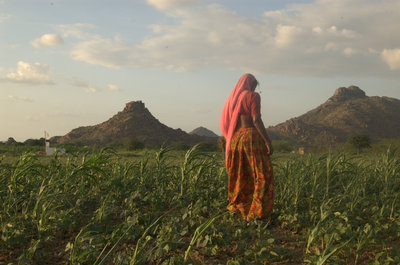Erika O'Conor | A Clash with Tradition| EXPOSURE/Aftermath Workshop in Ajmer

|
|
Audio Slideshow | Posted Jan 22, 2010
Program: Exposure
Tucked away between rocky hills and parched fields of wheat, there is a revolution underway in northern India. A new generation of rural Rajasthani women is mobilizing to challenge old traditions and pursue uncharted opportunities. As they look to move past their domestic horizons, they must not only navigate the complex social and cultural bonds that have defined life in the village for generations, but the mountain of legal and institutional structures that often remain a challenge for rural women who are still largely illiterate.
A dirt road leads to the quiet town of Sedria, where, surrounded by the mud houses of her family, Choti, blind and frail, sits listening to the sound of her great grandchildren at play. The memories of the older generation are filled with pain and struggle –hardship and tragedy seemed to mark life’s every milestone. Widowed little over a month ago, she whimpers to her daughter “The god of death will come now.” I watch as mother and daughter embrace and their eyes swell up with tears, tears accompanied by memories. “My mother was the youngest of eight daughters. Her father died very early, so the girls did hard labor work. My mother was married off when she was thirteen. No one was there for her when she had her first baby, at fourteen. She did not know why there was blood.” Despite laws and declarations that made child marriage illegal in India over sixty years ago, these practices were widespread in much of rural India until quite recently. Before, people endured these hardships, justifying it as their fate and the way of life. But no longer.
It is in villages like Dhana, a few kilometers away, that changes in women’s social and economic position is beginning to be felt. Sughani, a 45-year-old dalit woman has a confident air which does not suggest that she belongs to India’s lowest caste. “Before, there was the problem of untouchability. My mother told me not to mind the upper castes, to come straight home and not to talk to anyone. But now things are different. Now we work alongside all other castes. We eat together and drink the same water.” The social freedoms granted to members of the lowest caste have given some the opportunity for social mobility that half a decade ago would have seemed impossible. Sughani, though illiterate, has also achieved a level of economic stability that had previously been inconceivable, through diversifying the family’s production of goods, selling not only the crops she harvests, but also dairy products, bangles and paper plates.
Stepping out of the house and taking charge of their lives, the following generation of women has had to overcome centuries of social strictures and norms. Kiran, wife to Sughani’s eldest son, teaches at the village school, earning 1,500 rupees a month, more than her unemployed husband. “Men here do not like when their wives earn more than they do. If my father-in-law passes away, my husband will be the head of the family. He will be teased if his wife earns the money.” But with two children in private school, she and her husband confront this social pressure to give their children a better future. “I only get to see my son twice a year. I miss him very much, but I know that he is getting a good education and that is more important than anything.” Along with her teaching, Kiran also manages the household and her responsibilities in the fields. This is what women are expected to do and the compromises they must make as they strive to change traditional ideas about a woman's roles in the family and the community
Willing to make such sacrifices, the women of Sedria have taken their futures into their own hands, seeking out a local NGO, for support and funds. Madu, the mother of three, explains, “I speak with the other women from the village and if we need something I go to the NGO for resources. They provide the vaccinations we give to the pregnant women here.” Effective and essential healthcare for women in rural areas of India is often lacking. “Only five out of twenty women go to the hospital to have their babies delivered. It is six kilometers away, so by the time her labor pains start it is too late. Besides, the facilities at the hospital are not very good.” Also lacking in quality is the education system. “Most children from this village go work in the fields after they finish school, ” worries Madu, “The school in the village only offers class until the fifth year. The woman next to me, her daughter is the first girl from the village to go to the eleventh series.”
My two weeks amongst the women of these villages gave me a chance to experience the nature of these changes and the many social and bureaucratic challenges that must still be overcome to achieve them. What was clear is that, because of the determination and commitment of these women, change is inevitable, though it may continue to be slow and hindered by tradition. I could not help but feel that it was here, in small villages like Sedria and Dhana, that the future of India was being determined and that the success or failure of these changes would have a lasting impact on Indian society for generations to come.

